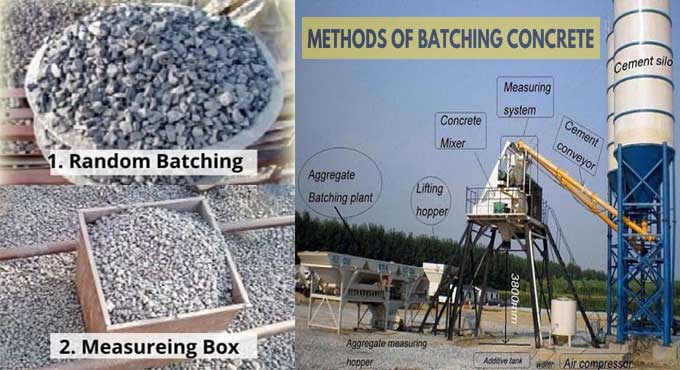
Methods of Batching Concrete
Concrete is a versatile, durable, sustainable, economical material, and world?s most widely used construction material. The proportion of concrete ingredients should accurately measure to make the excellent quality of concrete. One can accurately measure the concrete ingredients by carrying out the batching process.
- Batching is the process where the quantity or material proportions like cement, aggregates, water, etc. Those are measured based on either weight or volume to prepare the concrete mix.
- Proper Batching improves the workability of concrete by reducing the segregation or bleeding in concrete. It helps to get a smooth surface of the concrete. It also increases the construction speed and minimizes the wastage of concrete ingredients. Hence, batching of concrete is an essential process while making concrete.
- To form durable, sustainable, and economical concrete, one should have carried out the concrete mix design (CMD). The scientific and systematic process of choosing an economically relative proportion of various ingredients from the available material give cohesive concrete of the desired workability at the new stage with desired strength and durability in the hardened stages is known as Concrete mix design (CMD).
- Once concrete mix design carries out, the first task is batching concrete materials like cement, aggregates, admixture, etc. The concrete batching happened by measuring and combining required concrete ingredients either by weight or volume as per the mix design.
- Once materials batch, they are introduced into a concrete mixture to produce a uniform and homogeneous concrete mix. In the concrete mixer machine, cement, aggregates (sand or gravel), and water is added to form the concrete. The mixer machine not only achieves the concretes mix uniformity but also discharges it without disturbing that uniformity. The mechanism that mixes concrete knows the ?mechanical concrete mixer? or simply concrete mixer.
There are three batching modes of concrete ingredients. They are as follows:
A. Random Volumetric Batching of Concrete Ingredients
- Random volumetric batching is a batching process that cannot control the proportion of concrete ingredients like cement, aggregates, water, etc. It results in errors, and ultimately, the concrete may not achieves its designed strength.
- In random volumetric batching, the proportion of concrete ingredients cannot control due to the size and shape of containers. This practice is unscientific, crude and should never be allowed even for a small job.
B. Volume Batching of Concrete Ingredients
Volumetric batching of concrete does by using measurement boxes, locally known as ?farmas? or gauge boxes. In an ideal case, the volume of the farma is made equal to the weight of one bag of cement, 35 liters, or multiple thereof.
Concrete ingredients like fine aggregates (sand), 10 mm Coarse aggregates, or 40mm Coarse aggregates (Kapachi) are measuring by farmas or gauge boxes that the farmas or gauge boxes are perfectly filled. In volumetric batching, water is measured either in Kg or liters. The water meter uses to measure the water quantity while batching or use cans of water having a fixed volume.
C. Weigh Batching of Concrete Ingredients
- The proportion of concrete ingredients is decided by the weighing (batching plant) in concretes weight batching. It is done either by using ?weight batch? or by other equivalent weighing systems.
- Weigh batching system facilitates simple, flexible, and accurate. On large projects, automatic batching plants usually install, which helps in achieving ultimate quality and consistency. Depending upon the type of job, different types of weight batches are available in the market. Manual weight batching, semi-automatic weigh batching, and fully automatic weigh batching (batching plant).
- Water is an essential constituent and hence using optimum water is a must. Less water would make it concretely unworkable excess water will reduce the strength of concrete. Water must measure accurately in liters.
- The choice of batching method depends on the size of the job, production rate, and standards of batching performance.
Disadvantages of Poor Batching of Concrete Ingredients
(1) Poor batching of concrete ingredients directly impacts the strength of concrete. Because of poorly batching, concrete ingredients never mix homogeneously, workability will suffer.
(2) Poorly batched concrete ingredients may cause void formation in the concrete that leads to honeycombing.
(3) Poor batching also results in porous concrete becomes the reason for leakages in the house.
(4) The porous concrete may be the reason for corrosion and will ultimately reduce the structure life and increase the repair cost.
(5) Traditionally batching of concrete is done by volume. Batching accuracy is very important. However, weight batching is more preferred rather than volume batching. (6)Volume batching may be allowed only where weight batching is impractical. It is always advisable to spend a little bit extra on the concrete mix design and follow all the batching processes recommended by the designer, as in the long term, it will save you a fortune.
Note: The quantity of cement should also measure with an accuracy of ? 2 percent along with the number of aggregates. The admixture of water should measure accurately at ? 3 percent.


